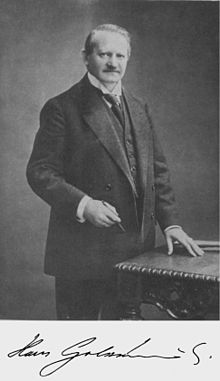This is an old revision of this page, as edited by 178.167.161.209 (talk) at 06:53, 8 February 2015 (he didn't invent it. As per the references I added and the talk page note I left. So I removed this misnomer and re-worded the article.). The present address (URL) is a permanent link to this revision, which may differ significantly from the current revision.
Revision as of 06:53, 8 February 2015 by 178.167.161.209 (talk) (he didn't invent it. As per the references I added and the talk page note I left. So I removed this misnomer and re-worded the article.)(diff) ← Previous revision | Latest revision (diff) | Newer revision → (diff)| Hans Goldschmidt | |
|---|---|
 | |
| Born | (1861-01-18)January 18, 1861 Berlin Germany |
| Died | May 21, 1923(1923-05-21) (aged 62) Baden Baden Germany |
| Nationality | German |
| Alma mater | University of Berlin |
| Awards | Elliott Cresson Medal (1904) |
| Scientific career | |
| Doctoral advisor | Robert Bunsen |
Johannes Wilhelm "Hans" Goldschmidt (January 18, 1861 – May 21, 1923) was a German chemist.
Born in Berlin, he was a student of Robert Bunsen. His father, Theodor Goldschmidt, was the founder of the chemical company Chemische Fabrik Th. Goldschmidt which eventually became part of the modern company Degussa, and Hans and his brother Karl managed this company for many years.
He is principally noted as the co-inventor of sodium amalgam and the initial patent holder of the thermite reaction. The thermite (or aluminothermic) reaction is one in which aluminum metal is oxidized by an oxide of another metal, usually iron oxide, producing great heat in the process. Goldschmidt was originally interested in producing very pure metals by avoiding the use of carbon in smelting, but he soon realized the value in welding, a process known as thermic welding. It is also used in incendiary devices. This process is sometimes called the "Goldschmidt reaction" or "Goldschmidt process", because he furthered its development and patented it in 1895. He would also go on to publish an extensive paper on it in 1898.
His grave is preserved in the Protestant Friedhof I der Jerusalems- und Neuen Kirchengemeinde (Cemetery No. I of the congregations of Jerusalem's Church and New Church) in Berlin-Kreuzberg, south of Hallesches Tor.
See also
- 1935 Thermit welding
References
- "Obituary: Hans Goldschmidt". Berichte der deutschen chemischen Gesellschaft. 56 (8): A77 – A79. 1923. doi:10.1002/cber.19230560867.
- History of the "Th. Goldschmidt AG" company: http://history.evonik.com/sites/geschichte/en/chemicals/history/goldschmidt/pages/default.aspx .
- 'U. S. patent to Hans Goldschmidt, No. 578,868. In this patent the patentee acknowledges that the alumino-thermic reaction was well known and had been used previously for producing metals and alloys.'
- 'U. S. patent to Hans Goldschmidt, No. 578,868. In this patent the patentee acknowledges that the alumino-thermic reaction was well known and had been used previously for producing metals and alloys.'
- H. Goldschmidt, "Verfahren zur Herstellung von Metallen oder Metalloiden oder Legierungen derselben" (Process for the production of metals or metalloids or alloys of the same), Deutsche Reichs Patent no. 96317 (13 March 1895).
- Goldschmidt, Hans; Ruhr, Essen a. d. (1898). "Über ein neues Verfahren zur Darstellung von Metallen und Legirungen mittelst Aluminiums ". Justus Liebigs Annalen der Chemie. 301 (1): 19–28. doi:10.1002/jlac.18983010103.
- Goldschmidt, Dr. Hans; Vautin, Claude (1898-06-30). "Aluminium as a Heating and Reducing Agent" (PDF). Journal of the Society of Chemical Industry. 6 (17): 543–545. Retrieved 2011-10-12.
- Goldschmidt, H., "Über ein neues Verfahren zur Erzeugung von hohen Temperaturen und zur Darstellung von schwer schmelzbaren kohlefreien Metallen" (On a new method for the production of high temperatures and for the preparation of refractory carbon-free metals), Zeitschrift für Elektrochemie, vol. 4, pages 494–499 (1898)
- Goldschmidt, H., "Verfahren zur Erzeugung hoher Temperaturen" (Method for the production of high temperatures), Zeitschrift für Elektrochemie, vol. 6, pages 53–57 (1899).